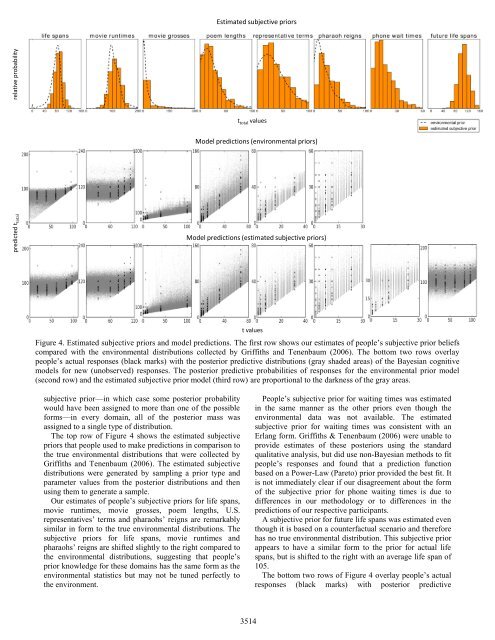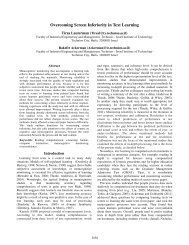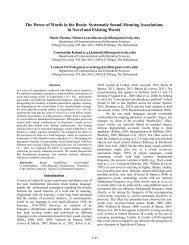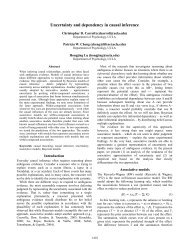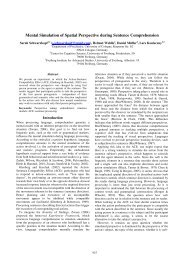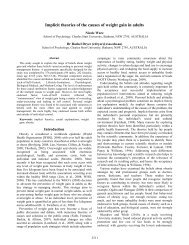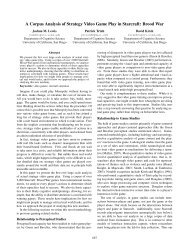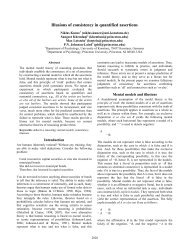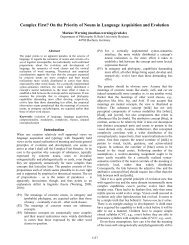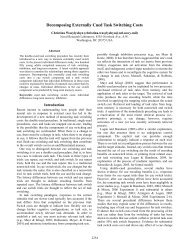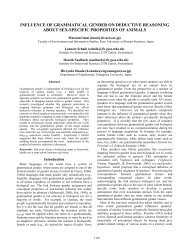Inferring Subjective Prior Knowledge: An ... - MindModeling.org
Inferring Subjective Prior Knowledge: An ... - MindModeling.org
Inferring Subjective Prior Knowledge: An ... - MindModeling.org
Create successful ePaper yourself
Turn your PDF publications into a flip-book with our unique Google optimized e-Paper software.
elative probability<br />
Estimated subjective priors<br />
t total values<br />
Model predictions (environmental priors)<br />
predicted t total<br />
Model predictions (estimated subjective priors)<br />
t values<br />
Figure 4. Estimated subjective priors and model predictions. The first row shows our estimates of people’s subjective prior beliefs<br />
compared with the environmental distributions collected by Griffiths and Tenenbaum (2006). The bottom two rows overlay<br />
people’s actual responses (black marks) with the posterior predictive distributions (gray shaded areas) of the Bayesian cognitive<br />
models for new (unobserved) responses. The posterior predictive probabilities of responses for the environmental prior model<br />
(second row) and the estimated subjective prior model (third row) are proportional to the darkness of the gray areas.<br />
subjective prior—in which case some posterior probability<br />
would have been assigned to more than one of the possible<br />
forms—in every domain, all of the posterior mass was<br />
assigned to a single type of distribution.<br />
The top row of Figure 4 shows the estimated subjective<br />
priors that people used to make predictions in comparison to<br />
the true environmental distributions that were collected by<br />
Griffiths and Tenenbaum (2006). The estimated subjective<br />
distributions were generated by sampling a prior type and<br />
parameter values from the posterior distributions and then<br />
using them to generate a sample.<br />
Our estimates of people’s subjective priors for life spans,<br />
movie runtimes, movie grosses, poem lengths, U.S.<br />
representatives’ terms and pharaohs’ reigns are remarkably<br />
similar in form to the true environmental distributions. The<br />
subjective priors for life spans, movie runtimes and<br />
pharaohs’ reigns are shifted slightly to the right compared to<br />
the environmental distributions, suggesting that people’s<br />
prior knowledge for these domains has the same form as the<br />
environmental statistics but may not be tuned perfectly to<br />
the environment.<br />
People’s subjective prior for waiting times was estimated<br />
in the same manner as the other priors even though the<br />
environmental data was not available. The estimated<br />
subjective prior for waiting times was consistent with an<br />
Erlang form. Griffiths & Tenenbaum (2006) were unable to<br />
provide estimates of these posteriors using the standard<br />
qualitative analysis, but did use non-Bayesian methods to fit<br />
people’s responses and found that a prediction function<br />
based on a Power-Law (Pareto) prior provided the best fit. It<br />
is not immediately clear if our disagreement about the form<br />
of the subjective prior for phone waiting times is due to<br />
differences in our methodology or to differences in the<br />
predictions of our respective participants.<br />
A subjective prior for future life spans was estimated even<br />
though it is based on a counterfactual scenario and therefore<br />
has no true environmental distribution. This subjective prior<br />
appears to have a similar form to the prior for actual life<br />
spans, but is shifted to the right with an average life span of<br />
105.<br />
The bottom two rows of Figure 4 overlay people’s actual<br />
responses (black marks) with posterior predictive<br />
3514


